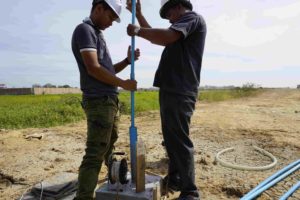Groundsearch – Groundwater wells
The company routinely runs groundwater projects to explore for water supplies. This includes well drilling, well testing, analysis of the data from the well, create models to predict aquifer sustainability
This study confirms yield and distribution of underground water-for irrigation and a city supply

water well drilling city water

well testing for irrigation
Well testing
This is the process of well testing after drilling. Testing a well for immediate and longer-term yield is crucial for assessing its sustainability and productivity. Here are some key points to consider:
- Immediate Yield Testing: This typically involves a short-term pump test to measure the well's initial flow rate. During this phase, you would monitor the water level in the well and the flow rate to evaluate the well's capacity.
- Long-Term Yield Testing: This usually involves a longer duration test (often several days to weeks) to assess how the well performs over time. It helps identify any fluctuations in yield and the potential for sustainable extraction.
- Data Analysis: Collect and analyze data on flow rates, water levels, and any changes over time to determine if the well can sustainably meet water demands without depleting the aquifer.
- Environmental Considerations: Ensure that testing and subsequent extraction do not negatively impact the surrounding ecosystem or nearby water sources.
- Regulatory Compliance: Check local regulations regarding well testing and water extraction to ensure compliance.
 Discharge pipe from well test
Discharge pipe from well test

Test Well location

monitoring piezometer
Well data analysis
The first step in analysis is to plot the well data versus time and measure aquifer yield

Water level graph
Groundwater terms
[1] Transmissivity is measured as the rate at which groundwater can flow through an aquifer section of unit width under a unit hydraulic gradient.
[1] The storativity of a confined aquifer is defined as the volume of water released from storage per unit surface area of the aquifer per unit decline in hydraulic head. Storativity is also known by the term’s coefficient of storage and storage coefficient
The storativity is confined or sealed under a surface layer if the S value is 1*10-4 or less In this case the water level will be above the top of the aquifer and may even be above the ground surface
The storativity is transitional or leaky if between 1 * 10-3 and 1* 10-4. This indicates that as drawdown increases (drops below top of aquifer) some water is released from the shallow confining layer and the drawdown graph will flatten. Effectivity this increases yield.
The storativity is unconfined or open to the surface if above 1*10-3. This means that the water is below the top /within the aquifer. The term specific yield or drainable porosity is a feature of this \type of aquifer of this and typically its less than 100%
A boundary is the effective edge of an aquifer. The drawdown will move out to a boundary over time as a surface. If is a closed boundary this means the aquifer will drawdown more quickly, but if it’s a river or lake the drawdown will flatten out. I would expect both boundaries are present in this area.

Create a starting groundwater model for irrigation supply
Contact
Contact Info
For info contact Grant Roberts:
Phone:
+855 10 863111
